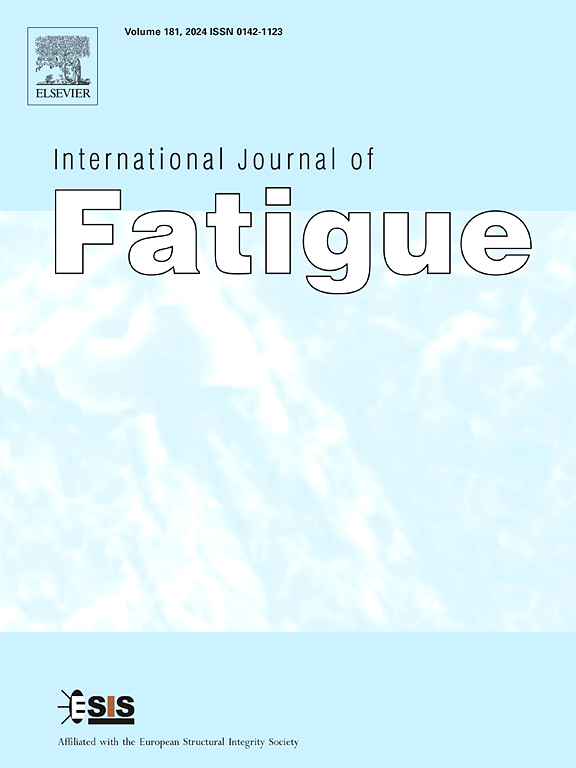Low-cycle fatigue bond behaviour between sand-coated hybrid FRP tubes and sustainable seawater sea sand concrete
IF 5.7
2区 材料科学
Q1 ENGINEERING, MECHANICAL
引用次数: 0
Abstract
This study examines the bond behaviour of sand-coated hybrid Fibre Reinforced Polymer (HFRP) tubes filled with seawater sea sand concrete (SWSSC) under static and cyclic axial loads through push-out tests. The HFRP tubes, manufactured from glass and carbon fibre-reinforced polymer composites, were tested under incrementally increasing cyclic loading. Four distinct displacement-controlled loading regimes were explored, with cycles repeated 1, 3, 5, and 10 times for each specified displacement. The results showed that bond strength and energy dissipation capacity decrease with increased cycle repetitions due to cumulative interface degradation, while static tests indicated higher bond strengths at smaller displacements. ANOVA analysis confirmed that although significant differences in bond strength were observed with varying cycle repetitions, the displacements corresponding to maximum bond strength remained statistically similar. Quantitatively, the bond strength decreased from an average of 2.35 MPa in the single-cycle regime to approximately 1.89 MPa in the 10-cycle regime (a reduction of around 19 %). At lower cyclic repetitions (1 and 3 cycles), failure was primarily characterised by partial debonding at the interfaces between the sand coating and both the SWSSC and the HFRP tube. With increasing cycle repetitions (5 and 10 cycles), the bond damage significantly escalated, and a shift to complete coating detachment occurred. The damage mechanism evolved from interface failure within the SWSSC/HFRP–sand coating layers to complete separation of the composite layers from the SWSSC. These results show how cumulative damage effectively undermines the interface bonding between the components, emphasising the relevance of considering the number of cycles in evaluating composite durability under real-world conditions. These findings can improve the design and durability assessment of HFRP-concrete composite structures, particularly in environments subjected to repetitive loading conditions.
涂砂复合FRP管与可持续海水海砂混凝土的低周疲劳粘结性能
本研究通过推出试验,研究了填入海水海砂混凝土(SWSSC)的涂砂混合纤维增强聚合物(HFRP)管在静载荷和循环轴向载荷下的粘结行为。HFRP管由玻璃和碳纤维增强聚合物复合材料制成,在逐渐增加的循环载荷下进行了测试。研究人员探索了四种不同的位移控制加载机制,每种指定的位移循环重复1、3、5和10次。结果表明,黏结强度和耗能能力随着循环次数的增加而降低,这是由于界面的累积退化,而静态试验表明,在较小的位移下,黏结强度更高。方差分析证实,虽然观察到不同循环次数的键合强度有显著差异,但最大键合强度对应的位移在统计学上保持相似。从数量上看,粘结强度从单循环时的平均2.35 MPa下降到10循环时的约1.89 MPa(降低约19%)。在较低的循环重复次数(1和3个循环)中,破坏的主要特征是砂涂层与SWSSC和HFRP管之间的界面部分脱落。随着循环次数的增加(5次和10次),粘结剂损伤显著升级,并发生完全涂层脱落的转变。损伤机制由SWSSC/ hfrp -砂包覆层内部界面破坏演变为复合层与SWSSC完全分离。这些结果显示了累积损伤如何有效地破坏了组件之间的界面粘合,强调了在实际条件下评估复合材料耐久性时考虑循环次数的相关性。这些发现可以改进hfrp -混凝土复合结构的设计和耐久性评估,特别是在重复荷载条件下的环境中。
本文章由计算机程序翻译,如有差异,请以英文原文为准。
求助全文
约1分钟内获得全文
求助全文
来源期刊

International Journal of Fatigue
工程技术-材料科学:综合
CiteScore
10.70
自引率
21.70%
发文量
619
审稿时长
58 days
期刊介绍:
Typical subjects discussed in International Journal of Fatigue address:
Novel fatigue testing and characterization methods (new kinds of fatigue tests, critical evaluation of existing methods, in situ measurement of fatigue degradation, non-contact field measurements)
Multiaxial fatigue and complex loading effects of materials and structures, exploring state-of-the-art concepts in degradation under cyclic loading
Fatigue in the very high cycle regime, including failure mode transitions from surface to subsurface, effects of surface treatment, processing, and loading conditions
Modeling (including degradation processes and related driving forces, multiscale/multi-resolution methods, computational hierarchical and concurrent methods for coupled component and material responses, novel methods for notch root analysis, fracture mechanics, damage mechanics, crack growth kinetics, life prediction and durability, and prediction of stochastic fatigue behavior reflecting microstructure and service conditions)
Models for early stages of fatigue crack formation and growth that explicitly consider microstructure and relevant materials science aspects
Understanding the influence or manufacturing and processing route on fatigue degradation, and embedding this understanding in more predictive schemes for mitigation and design against fatigue
Prognosis and damage state awareness (including sensors, monitoring, methodology, interactive control, accelerated methods, data interpretation)
Applications of technologies associated with fatigue and their implications for structural integrity and reliability. This includes issues related to design, operation and maintenance, i.e., life cycle engineering
Smart materials and structures that can sense and mitigate fatigue degradation
Fatigue of devices and structures at small scales, including effects of process route and surfaces/interfaces.
 求助内容:
求助内容: 应助结果提醒方式:
应助结果提醒方式:


